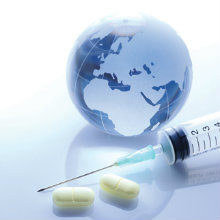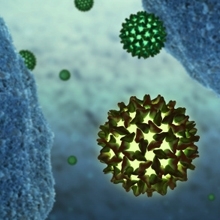Cancers attributable to infection - the global burden
Issue: Viruses and Cancer - 2013
18 February 2013 article

ROBERT NEWTON
Using global data on cancer incidence and mortality from 2008, it was estimated that there were 12.7 million new cancer cases that year and 7.6 million deaths; about two-thirds of cancer deaths occurred in less-developed countries. Of those cancer cases, about 16% (approximately 2 million cases) were estimated to be attributable to infections (viruses, macro-parasites and a bacterium). About 1.9 million cases were caused by human papillomaviruses (HPVs), hepatitis B and C viruses (HBV and HCV) and the gastric bacterium Helicobacter pylori. The proportion of cancers caused by infection tends to be higher in less-developed than in developed regions (approximately 23 versus 7%), reflecting the background prevalence of the underlying causal infections; indeed in parts of sub-Saharan Africa, the proportion is more than a third of all cancer cases. Among women, carcinoma of the uterine cervix is by far the most common infection-associated cancer (about 50% of the total) and, in men, liver and gastric cancers account for about 80% of the total. Those cancers that are attributable, at least in part, to underlying infections are shown in Table 1.
Estimating the burden and geographical distribution of cancer and specifically of infection-associated cancer is far from straightforward. Cancer incidence is defined as the frequency of new cases of cancer in a defined population over a specific time period and accurate data are important, not just for identifying levels of disease, prioritising health service activity and monitoring success of cancer control initiatives, but also because understanding patterns of disease occurrence underpins epidemiology and can provide insights into aetiology. For example, Denis Burkitt’s careful mapping of the distribution of the tumour that now bears his name led him to postulate an underlying infectious cause, ultimately leading to the discovery of the first human oncogenic virus – the Epstein–Barr Virus (EBV).
The series Cancer Incidence in Five Continents (CI5), first published in 1962 and soon to emerge in its 10th volume, compiles and presents incidence data from the best (as defined by highly specific criteria for data quality and completeness) population-based cancer registries in the world. However, there is significant geographic variation in the availability of such data – whilst the most recent volume of CI5 covers about 83% of the population of North America, 6, 4 and 1% of the populations of South America, Asia and Africa, respectively, are covered by such registries. Taking Africa as an example, out of 53 countries, only five have cancer registries of sufficient quality to be included in the latest volume of CI5 – Algeria, Egypt, Tunisia, Uganda and Zimbabwe (http://globocan.iarc.fr). In addition, there are around 50 local registries (which do not meet the stringent inclusion criteria for CI5) covering a further 7% of the African population, although these predominantly encompass urban rather than rural areas. In such countries, cancer registration is bedevilled by three related problems: (i) inadequate characterisation of disease – histological verification of diagnosis is typically only available for a proportion of cases; (ii) incomplete ascertainment of cases, particularly at older ages; and (iii) inadequate ascertainment of population denominator data (from a census). Therefore, any assessment of the burden of cancer – and within that, the burden just of those cancers caused by infections – is complex and potentially inaccurate.
In addition to the problems of measuring the burden of specific cancers highlighted above, there are other concerns associated with estimating the proportion of each cancer type caused by specific infections (the Population Attributable Fraction). It requires the best available evidence on the causal effect of each infection together with an accurate estimate of the prevalence of infection among cases (which may vary by geographic region). Inevitably, the estimates rely both on the quality of source data and, where data are few, on the statistical methods used to overcome these problems. For example, human papillomavirus (HPV) is considered to be a necessary cause of cancer of the cervix and Kaposi’s sarcoma-associated herpesvirus (KSHV) of Kaposi’s sarcoma, but EBV or human T-cell leukaemia virus type 1 (HTLV-1) cause only a proportion of lymphomas and leukaemias. Nor do these estimates take into account the impact of multiple infections on cancer risk, such as the combined effects of EBV and malaria on the risk of Burkitt’s lymphoma.

One further problem, of course, is that there may be other cancer sites or types, not listed in Table 1, that have an underlying infectious aetiology yet to be discovered. For example, the substantial excess risk of cutaneous squamous cell carcinoma among immune-suppressed individuals has led many to suspect an underlying infectious aetiology – certain cutaneous HPV types have been investigated, but evidence remains scant. Historically, such epidemiological clues have provided the evidence required to prompt a search for an underlying infectious cause of cancer. The extraordinary geographic variation in the incidence of Burkitt’s lymphoma and its association with the distribution of holo-endemic malaria is a classic example. Take too, the association of cancer of the cervix with sexual behaviour, highlighted in a seminal paper by Beral in 1974 (and followed by others), which led to the identification of the sexually transmitted infection HPV-16 by zur Hausen and colleagues in 1983. Similarly, the distinctive epidemiological features of Kaposi’s sarcoma – again highlighted by Beral and others – prompted a search for the underlying infectious cause, subsequently identified by Chang & Moore in 1994. More recently, the association between human immunodeficiency virus (HIV)-related immune suppression and Merkel cell carcinoma prompted the discovery of Merkel cell polyomavirus (MCV), again by Chang & Moore. Indeed, throughout the history of infections and cancer, it is the multi-disciplinary combination of epidemiology and virology that has proved highly successful in uncovering the causes of a range of malignancies.
Understanding the role of infections as a cause of cancer is important, since many infection-associated tumours are avoidable. For example, malignancies caused by HPV and HBV are preventable by vaccination. Most notably, in Taiwan, the incidence of hepatocellular carcinoma has fallen markedly since the introduction of vaccination against HBV, coupled with the provision of immunoglobulin at birth to prevent vertical transmission. Similarly, vaccines against HPV have shown nearly 100% efficacy in preventing HPV-16 and -18-induced precancerous lesions of the cervix. No vaccine is yet commercially available for any other cancer-causing infection, but for HCV, iatrogenic transmission can be avoided with safer injection and transfusion practices. This is true for some HIV infections, which can also be avoided via behaviour change and, more recently, by widespread use of anti-retroviral drugs, which reduce transmission of infection at a population level. Perinatal transmission of HTLV-1 has been greatly reduced in Japan by avoidance of prolonged breast-feeding, although this is not an option for many developing countries, where alternatives may not be available and where the risk of death from diarrhoeal disease rises markedly if breast-feeding is curtailed. H. pylori is a treatable infection and indeed prevalence of infection – and incidence of stomach cancer – has been falling in many populations for years. The value of large-scale eradication trials, however, remains uncertain.
So, the prospects for prevention of infection-associated cancers are good, although it may be decades before the impact of prevention programmes are manifest in the general population. It also seems likely that further discoveries will be made, linking known or novel infections to additional cancer sites or types. Finally, the growing importance of co-infection as a risk factor for certain cancers is becoming better recognised and presents fresh challenges to the research community.
Table 1. Cancers caused, at least in part, by infectious agents
|
Infectious agent(s) |
Cancers |
|
Epstein–Barr virus |
Nasopharyngeal carcinoma, Burkitt’s lymphoma, post-transplant lymphoproliferative |
|
Hepatitis B virus |
Hepatocellular carcinoma, cholangiocarcinoma, non-Hodgkin lymphoma |
|
Hepatitis C virus |
Hepatocellular carcinoma, cholangiocarcinoma, non-Hodgkin lymphoma |
|
Kaposi’s sarcoma-associated herpesvirus |
Kaposi’s sarcoma, primary effusion lymphoma, multicentric Castleman’s disease |
|
Human immunodeficiency virus type 1 |
Kaposi’s sarcoma, non-Hodgkin lymphoma, Hodgkin lymphoma, carcinomas of the cervix, anus and conjunctiva (possibly also the vulva, vagina, penis and liver) [note: HIV-2 has been associated with Kaposi’s sarcoma and non-Hodgkin lymphoma] |
|
Human papillomavirus type 16 |
Carcinomas of the cervix, vulva, vagina, penis, anus, oral cavity, oropharynx, larynx and tonsils [note: HPVs 18, 31, 33, 35, 45, 52, 58 and to a lesser extent, 39, 51, 56, 59, have also been associated with cancer of the cervix in particular] |
|
Human T-cell leukaemia virus type 1 |
Adult T cell leukaemia/lymphoma |
|
Merkel cell polyomavirus |
Merkel cell carcinoma |
|
Helicobacter pylori |
Non-cardia gastric carcinoma, gastric B-cell lymphoma of mucosa-associated lymphoid tissue |
|
Clonorchis sinensis |
Cholangiocarcinoma |
|
Opisthorchis viverrini |
Cholangiocarcinoma |
|
Schistosoma haematobium |
Urinary bladder cancer [note: Schistosoma japonicum has also been linked with colorectal and liver cancers] |
|
Malaria |
Burkitt’s lymphoma |
For most of the associations shown, the evidence has been considered robust enough that the International Agency for Research on Cancer (IARC) have classified the infections as being Group 1 carcinogens (definitely carcinogenic to humans). For Merkel cell polyomavirus and malaria, the classification is Group 2A (probably carcinogenic to humans).
ROBERT NEWTON
Senior Clinical Epidemiologist at the MRC/UVRI Research Unit on AIDS, PO Box 49, Entebbe, Uganda; Reader in Clinical Epidemiology at the University of York; and Senior Visiting Scientist at the International Agency for Research on Cancer, Lyon, France; Email [email protected] or [email protected]
Further reading
Beral, V. (1974). Cancer of the cervix: a sexually transmitted infection? Lancet 1, 1037–1040.
Beral, V., Peterman, T.A., Berkelman, R.L. & Jaffe, H.W. (1990). Kaposi’s sarcoma among persons with AIDS: a sexually transmitted infection? Lancet 35, 123–128.
Bouvard, V., Baan, R., Straif, K. & others (2009). A review of human carcinogens – Part B: Biological Agents. Lancet Oncol 10, 321–322.
Bouvard, V., Baan, R., Grosse, Y. & others (2012). Carcinogenicity of malaria and of some polyomaviruses. Lancet Oncol 13, 339–340.
Burkitt, D. (1962). A children’s cancer dependent on climatic factors. Nature 194, 232–234.
Chang, Y., Cesarman, E., Pessin, M.S. & others (1994). Identification of herpesvirus-like DNA sequences in AIDS-associated Kaposi’s sarcoma. Science 266, 1865–1869.
Chang, M.H., You, S.L., Chen, C.J. & others (2009). Decreased incidence of hepatocellular carcinoma in hepatitis B vaccines: a 20-year follow-up study. J Natl Cancer Inst 101, 1348–1355.
de Martel, C., Ferlay, J., Franceschi, S. & others (2012). Global burden of cancers attributable to infections in 2008: a review and synthetic analysis. Lancet Oncol 13, 607–615.
Doll, R., Payne, P. & Waterhouse, J., eds (1966). Cancer Incidence in Five Continents: a Technical Report. International Union against Cancer. Springer.
Durst, M., Gissmann, L., Ikenberg, H. & zur Hausen, H. (1983). A papillomavirus DNA from a cervical carcinoma and its prevalence in cancer biopsy samples from different geographic regions. Proc Natl Acad Sci U S A 80, 3812–3815.
Feng, H., Shuda, M., Chang, Y. & Moore, P.S.
(2008). Clonal integration of a polyomavirus in
human Merkel cell carcinoma. Science 319, 1096–1100.
Ferlay, J., Shin, H.R., Bray, F., Forman, D., Mathers, C. & Parkin, D.M. (2010). Estimates of the worldwide burden of cancer in 2008: GLOBOCAN 2008. Int J Cancer 127, 2893–2917.
Image: iStockphoto / Thinkstock.
